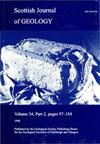深入挖掘:历史采矿对格拉斯哥地下热状态的影响,为地热研究提供信息
IF 0.5
4区 地球科学
Q4 GEOLOGY
引用次数: 7
摘要
对泰恩赛德(Tyneside)前英格兰东北部煤田的研究表明,钻孔中的热流扰动是由于地下深处的热量通过淹水矿井被夹带和横向分散造成的。这项工作评估了历史采矿对大格拉斯哥地区地热观测的影响。格拉斯哥的区域热流为60 mW m - 2,经古气候校正后,估计为约80 mW m - 2。在Hallside(格拉斯哥东南约10公里)观察到一个矿井上方热流减少的例子,在那里,通过352米深的钻孔的热流为约14 mW m - 2。同样,格拉斯哥地热能研究场址(Glasgow Geothermal Energy Research Field Site) 199 m深GGC01钻孔的热流为0.44 mW m−2。这些数值与预期区域热流之间的差异表明,水平热流的重要组成部分进入周围的矿井掘进。这种推断也影响了深层地热资源的量化,因为外推矿井工作上方的温度梯度会低估深层温度。未来的项目应该考虑历史采矿对热流的影响,当这些温度数据集用于地热开发的设计时。补充材料:关于每个钻孔位置的历史采矿年表的背景信息和格拉斯哥地下矿山工作的地下水流动摘要,可在https://doi.org/10.6084/m9.figshare.c.4681100上获得专题收集:这篇文章是“早期职业研究”的一部分,可在https://www.lyellcollection.org/cc/SJG-early-career-research上获得本文章由计算机程序翻译,如有差异,请以英文原文为准。
Digging deeper: The influence of historical mining on Glasgow's subsurface thermal state to inform geothermal research
Studies of the former NE England coalfield in Tyneside demonstrated that heat flow perturbations in boreholes were due to the entrainment and lateral dispersion of heat from deeper in the subsurface through flooded mine workings. This work assesses the influence of historical mining on geothermal observations across Greater Glasgow. The regional heat flow for Glasgow is 60 mW m−2 and, after correction for palaeoclimate, is estimated as c. 80 mW m−2. An example of reduced heat flow above mine workings is observed at Hallside (c. 10 km SE of Glasgow), where the heat flow through a 352 m deep borehole is c. 14 mW m−2. Similarly, the heat flow across the 199 m deep GGC01 borehole in the Glasgow Geothermal Energy Research Field Site is c. 44 mW m−2. The differences between these values and the expected regional heat flow suggest a significant component of horizontal heat flow into surrounding flooded mine workings. This deduction also influences the quantification of deeper geothermal resources, as extrapolation of the temperature gradient above mine workings would underestimate the temperature at depth. Future projects should consider the influence of historical mining on heat flow when temperature datasets such as these are used in the design of geothermal developments. Supplementary material: Background information on the chronology of historical mining at each borehole location and a summary of groundwater flow in mine workings beneath Glasgow are available at https://doi.org/10.6084/m9.figshare.c.4681100 Thematic collection: This article is part of the ‘Early Career Research’ available at: https://www.lyellcollection.org/cc/SJG-early-career-research
求助全文
通过发布文献求助,成功后即可免费获取论文全文。
去求助
来源期刊

Scottish Journal of Geology
地学-地质学
CiteScore
1.70
自引率
0.00%
发文量
10
审稿时长
>12 weeks
期刊介绍:
Although published only since 1965, the Scottish Journal of Geology has a long pedigree. It is the joint publication of the Geological Society of Glasgow and the Edinburgh Geological Society, which prior to 1965 published separate Transactions: from 1860 in the case of Glasgow and 1863 for Edinburgh.
Traditionally, the Journal has acted as the focus for papers on all aspects of Scottish geology and its contiguous areas, including the surrounding seas. The publication policy has always been outward looking, with the Editors encouraging review papers and papers on broader aspects of the Earth sciences that cannot be discussed solely in terms of Scottish geology.
The diverse geology of Scotland continues to provide an important natural laboratory for the study of earth sciences; many seminal studies in geology have been carried out on Scottish rocks, and over the years the results of much of this work had been published in the Journal and its predecessors.
The Journal fully deserves its high reputation worldwide and intends to maintain its status in the front rank of publications in the Earth sciences.
 求助内容:
求助内容: 应助结果提醒方式:
应助结果提醒方式:


